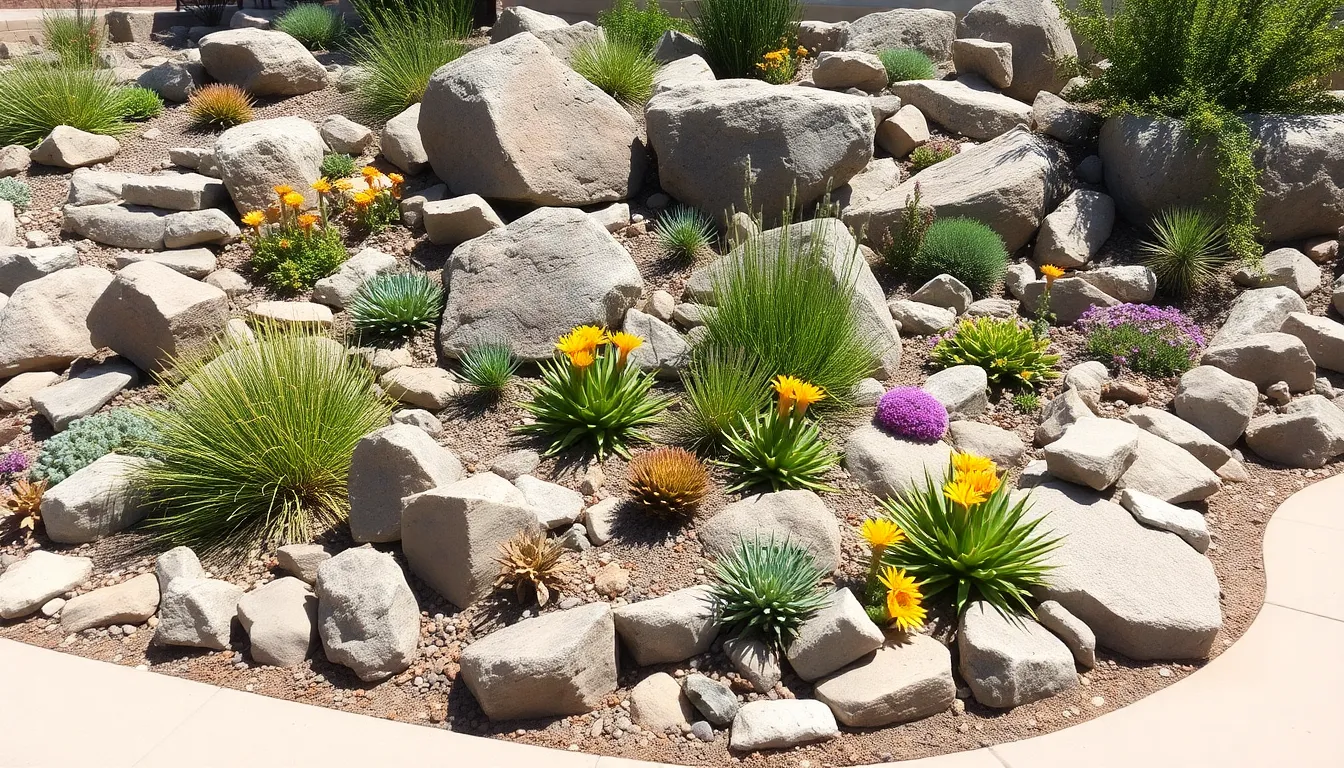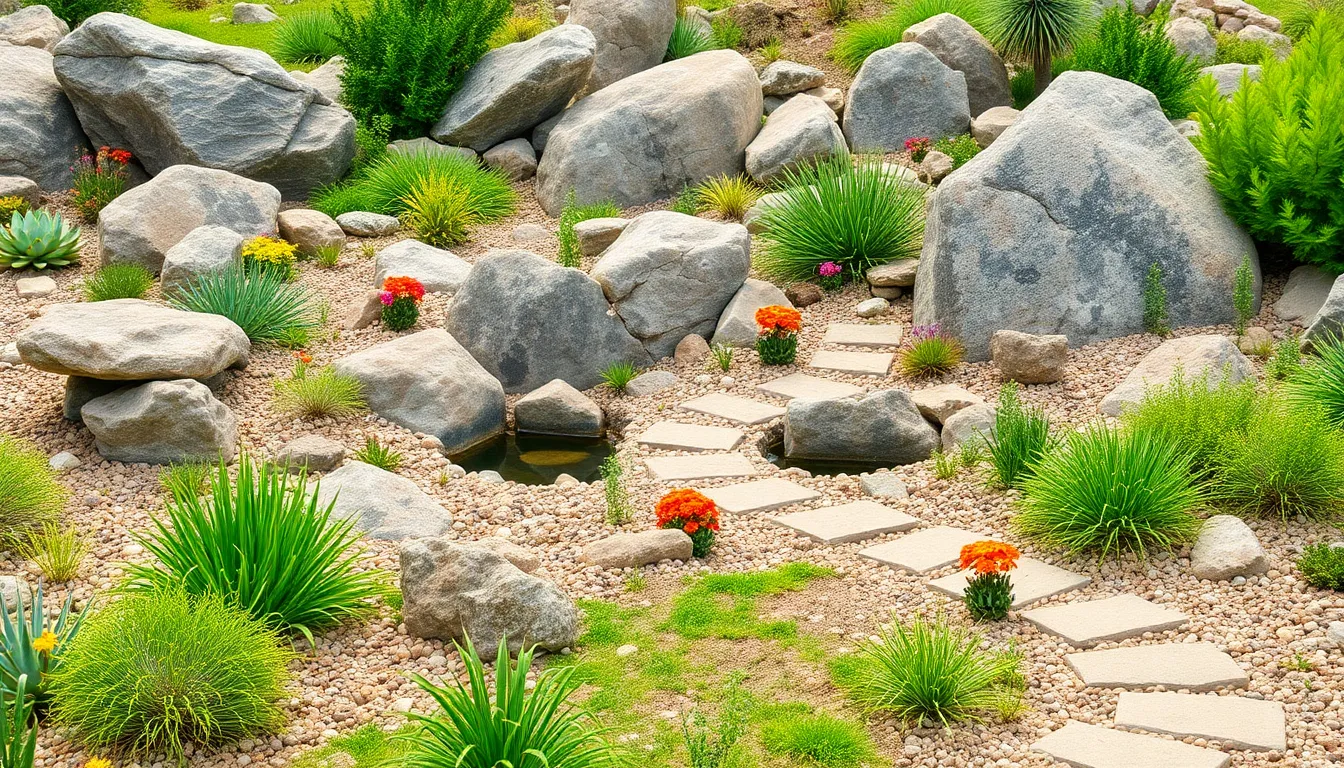Imagine transforming your yard into a stunning oasis with just a few rocks and some creativity. Rock gardens are the unsung heroes of landscaping—low maintenance, eco-friendly, and bursting with personality. They’re like the cool kids of the garden world, effortlessly blending beauty with practicality.
Whether you’re a seasoned gardener or just starting out, rock gardens offer endless possibilities. From dramatic boulders to delicate pebbles, these landscapes can showcase your unique style while providing a habitat for local wildlife. Plus, who wouldn’t want to brag about their very own mini mountain range? Dive into these rock garden landscaping ideas and discover how to elevate your outdoor space into a jaw-dropping retreat that’s sure to impress.
Rock Garden Landscaping Ideas
Rock gardens present diverse landscaping possibilities that transform any outdoor space into a stunning retreat. A thoughtful arrangement of stones, plants, and ornamental features adds unique character. Various designs appeal to different preferences, from contemporary to traditional aesthetics.
Integrating large boulders creates a dramatic focal point. These large stones serve as anchors for the garden, establishing a solid structure. Smaller pebbles or gravel can fill the gaps, contributing to a clean, organized look.
Choosing the right plants enhances the overall effect. Drought-resistant species thrive in rock gardens, promoting sustainability. Succulents and alpine plants exhibit vibrant colors and textures that contrast beautifully with stones. Local wildlife benefits from these gardens, creating habitats while attracting butterflies and beneficial insects.
Incorporating pathways within the rock garden promotes accessibility. Flagstone or slate paths create inviting trails for guests, encouraging exploration. Lighting features can enhance safety and highlight key elements during evening hours.
Adding water features, such as small ponds or fountains, increases visual interest. The tranquil sound of water creates a serene atmosphere, elevating the garden’s appeal. Rock gardens also integrate well with existing landscapes, enhancing nearby flowerbeds or lawns.
Rock gardens combine aesthetics, low maintenance, and sustainability. Different styles and elements allow for personalization, enabling unique expressions of creativity in landscaping. Different materials and plant choices yield specific visual themes, providing endless possibilities for gardeners.
Benefits Of Rock Gardens

Rock gardens offer several advantages for outdoor spaces. Their unique design creates visual appeal while providing functional benefits.
Low Maintenance Requirements
Low maintenance characterizes rock gardens, making them attractive to many homeowners. These gardens require minimal upkeep, with fewer weeds and less frequent watering. Rocks and stones inhibit weed growth, reducing the need for herbicides or constant weeding. Additionally, drought-resistant plants like succulents thrive without much attention. Choosing hardy plants ensures resilience against harsh weather conditions. The absence of expansive lawns means less mowing and trimming. Overall, the simplicity of maintenance saves time and effort.
Environmental Sustainability
Environmental sustainability is a significant benefit of rock gardens. They promote water conservation by using drought-tolerant plants that require minimal irrigation. Additionally, repurposing stones for landscaping reduces the need for processed materials. These gardens enhance local biodiversity by providing habitat for various wildlife species. Native plant selections support the local ecosystem, fostering a balanced environment. Furthermore, the overall design minimizes soil erosion, preserving landscape integrity. Sustainable gardening practices contribute positively to the surrounding flora and fauna.
Design Elements Of A Rock Garden
Rock gardens combine various elements to create captivating landscapes. They focus on natural aesthetics while promoting sustainability.
Selecting The Right Rocks
Choosing the right rocks shapes the overall design. Use a mix of sizes and textures to create visual interest. Large boulders can serve as striking focal points, while smaller stones fill gaps and provide balance. Local stone options fit seamlessly into the environment and add authenticity. When selecting rocks, consider the colors of surrounding plants to enhance harmony. Smooth pebbles create a contrasting effect against rugged stones. Variety promotes depth and intrigue, making the rock garden more visually appealing.
Incorporating Plants And Flowers
Selecting plants and flowers enhances the rock garden’s beauty. Drought-resistant varieties thrive in rocky environments and require minimal maintenance. Succulents, alpine species, and ornamental grasses are excellent choices. Place low-growing plants at the forefront to avoid overshadowing taller specimens. Grouping plants in clusters establishes natural patterns while allowing for visual rhythm. Additionally, native plants attract local wildlife and support biodiversity. Consider seasonal blooms for added color throughout the year. Incorporating decorative elements, like small sculptures or garden art, further enriches the landscape.
Popular Rock Garden Styles
Rock gardens come in various styles, each offering unique aesthetics and benefits. Two popular styles are Japanese Zen gardens and rustic natural designs.
Japanese Zen Gardens
Japanese Zen gardens emphasize tranquility and meditation. Typically, these gardens feature sand or gravel raked into intricate patterns, symbolizing water ripples. Large stones represent mountains or islands, creating a serene atmosphere. Incorporating moss and carefully placed plants adds a touch of greenery. Bamboo fences and stone lanterns enhance the peaceful ambiance. Minimalistic approaches allow for clear paths, promoting mindfulness. Overall, Japanese Zen gardens showcase simplicity and balance, making them ideal for relaxation.
Rustic And Natural Designs
Rustic natural designs celebrate the beauty of organic elements. These gardens integrate local stones, weathered wood, and native plants, enhancing the natural landscape. Use of large boulders creates eye-catching focal points, while smaller rocks fill gaps between plants. Varieties like wildflowers and groundcovers thrive in such settings, attracting local wildlife. Meandering pathways made of stone or mulch promote exploration. Decorative features like birdhouses or log benches add charm. Rustic designs blend seamlessly with the environment, providing an inviting outdoor space.
Tips For Successful Rock Garden Landscaping
Successful rock garden landscaping revolves around thoughtful planning and strategic execution. Key aspects include site selection and ensuring effective drainage.
Choosing The Right Location
Selecting the ideal spot for a rock garden significantly impacts its success. Identify areas with good sunlight since most drought-resistant plants thrive in direct light. Position gardens where soil drains well, avoiding spots that retain water. Consider proximity to outdoor living spaces, creating inviting views from patios or decks. Observe existing landscape features to blend the garden naturally with surroundings. Encourage accessibility by placing the rock garden near pathways.
Planning Drainage Solutions
Effective drainage strategies prevent water accumulation and encourage healthy plant growth. Assess the current landscape for natural slopes that direct water away from the garden. Use rocks to create raised surfaces, promoting runoff while enhancing visual interest. Incorporate permeable materials like gravel or sand into the soil mix to improve drainage. Plan for water flow by installing dry riverbeds or trenches, capturing excess water. Evaluate options for downspouts or drainage systems to protect plants from excess moisture. Each effort contributes to a sustainable, thriving rock garden.
Conclusion
Rock gardens offer a captivating blend of beauty and practicality for any outdoor space. Their low maintenance requirements and eco-friendly attributes make them an ideal choice for homeowners seeking sustainable landscaping solutions. By thoughtfully arranging stones and selecting the right plants, individuals can create unique environments that not only enhance visual appeal but also support local wildlife.
Whether opting for a serene Japanese Zen garden or a rustic natural design, the possibilities are endless. With careful planning and creativity, rock gardens can transform ordinary yards into extraordinary retreats that invite relaxation and exploration. Embracing these landscaping ideas can lead to a stunning outdoor oasis that reflects personal style while benefiting the environment.

